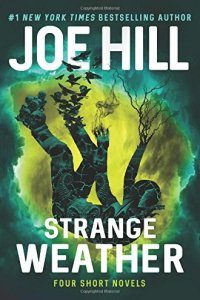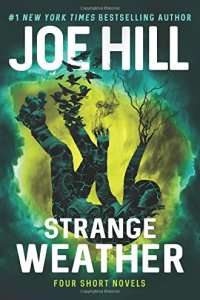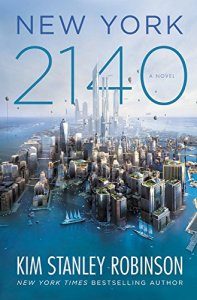John Langan Reviews Strange Weather by Joe Hill
 Strange Weather, Joe Hill (William Morrow 978-0-06-266311-5, $27.99, 448pp, hc) October 2017.
Strange Weather, Joe Hill (William Morrow 978-0-06-266311-5, $27.99, 448pp, hc) October 2017.
Henry James famously called the novella the “blessed form,” and it’s long been a truism that the form is especially well-suited to horror narratives, offering sufficient length to develop character and situation, but sufficient concentration to focus effect. James’s own The Turn of the Screw exemplifies this combination, as do many of the most famous examples of the field, from Machen’s “The Great God Pan” to LaValle’s The Ballad of Black Tom. So it’s no surprise that a writer such as Joe Hill would want to work at this length. As he tells us in the afterword to Strange Weather, his collection of four gripping novellas, his excursions into the form came in the wake of his most recent – and considerably longer – novels, NOS4A2 and The Fireman, and it’s not difficult to see them as arising from a desire to write a more distilled fiction after the expansiveness of the novels.
Yet there’s also a more significant connection between the novellas and the novels they flank, a way in which they continue to engage the novels’ themes and concerns. “Snapshot”, the book’s opening story, concerns a teenaged boy who encounters a sinister figure he christens the Phoenician, who carries a Polaroid camera whose instant photos strip their subjects of memories. The protagonist witnesses the effect of the camera on his family’s former housekeeper, a kindly, older woman who appears to be experiencing the symptoms of moderate Alzheimer’s disease, but is in fact being victimized by the Phoenician because of something she saw when she was younger. In the person of the malevolent man with a pierce of weird technology which allows him to vampirize others, Hill writes another iteration of Charlie Manx, the antagonist of NOS4A2. Where Manx targeted children, the Phoenician victimizes an old woman, but their predation on members of vulnerable populations unites them. And in both narratives, the villain is opposed by a child. Perhaps the most important difference between novella and novel lies in the former’s extended dénouement, which details the narrator’s continued involvement with his former housekeeper as her condition worsens, the Phoenician’s camera having set in motion a process that is, for all intents and purposes, Alzheimer’s disease. Although the antagonist may have been dealt with, his victim remains, and that stubborn fact steers the story into unexpectedly emotional territory. (There’s also what may be a reference to Lauren Beukes’s fine novel, The Shining Girls.)
“Loaded”, the collection’s second novella, is according to Hill its oldest in conception but most recent in completion, having been finished in late 2016. Yet in its setting in a Florida city plagued by a forest fire which stubbornly resists efforts to bring it under control, there’s a strong echo of The Fireman‘s world in flames. The steadily escalating conflagration embodies both the frustration and rage building within the story’s antagonist, and the wider cultural moment vis à vis the United States’ obsession with firearms. As far as symbolic landscapes go, it’s not an especially subtle one, but it isn’t meant to be. “Loaded” is a deliberately polemical story, its terrible inspiration the massacre of schoolchildren at Sandy Hook elementary school in 2012. It’s a story with no supernatural elements, but in its dive into its antagonist’s overheated brain, it descends into nightmare territory. The result is noir of a kind Jim Thompson would have recognized. As Terrence Rafferty has written, though, the noir setting might be thought of as the horror universe without the supernatural element, and it is in this convergence that “Loaded” lives, all the way to its unforgiving last line.
After the inferno of the book’s second entry, its third novella, “Aloft”, is a more airy affair – literally, as it concerns a reluctant skydiver who exits his plane only to land immediately on a surprisingly solid cloud. It’s a scenario that evokes Ray Bradbury’s stories, particularly in the way it explores the darker avenues of an apparently whimsical scenario. Not only is the cloud solid, it responds to the protagonist’s thoughts, manifesting reasonably solid facsimiles of whatever he envisions. As he’s still caught in an unresolved, unrequited love for a woman who has died, this transforms the cloudscape into a vast theater of his psychology. The narrative’s explanation for the cloud expands this aspect of it in the direction of the Kirby-esque sublime. “Aloft” was written while Hill was touring to support The Fireman, and it’s possible to read the story as inverting the book’s large cast of characters facing global calamity to a single character facing a personal(ized) challenge. At the same time, the individual adrift from the larger world is a situation to which The Fireman returns to time and again, to its concluding image, so there are deeper continuities between the novel and novella.
It isn’t hard to find the connections between Strange Weather‘s fourth and final story, “Rain”, and The Fireman: as Hill notes, the novella arose from a desire to “spoof” the novel’s apocalyptic pretensions. Certainly, the world-ending catastrophe it envisions, in which clouds suddenly begin to rain crystal shards that shred any human, animal, or vegetation caught in the open, is an escalation from The Fireman‘s incendiary fungus. There’s a quest across a landscape devastated by the new precipitation that showcases its ruinous effect. (It’s fascinating to note how fundamental the quest narrative is to the apocalyptic scenario.) However much “Rain” may have its origins in the impulse to self-parody, though, it’s a compelling story of its narrator-protagonist’s journey to check on her newly dead girlfriend’s father. Against the ravaged topography over which she travels, her mission takes on a stark, almost mythic grandeur. If the novella’s situation resembles something from the work of Bradbury or Richard Matheson, its execution looks in the direction of Cormac McCarthy’s The Road.
For those interested in doing so, it’s possible to read Strange Weather as Hill’s response to Stephen King’s Different Seasons. To be fair, between its title and its quartet of novellas, this is a comparison Strange Weather allows and even invites. Yet what seems more significant is the extent to which three of the collection’s four novellas are in some form of dialogue with The Fireman. It’s an index of the extent to which the novel sits at the heart of Hill’s recent writing, and, together, novel and novellas highlight a series of shared concerns, from the collapse of the world as we know it in a kind of slow-motion apocalypse, to the individual alone in a hostile environment, to the temptations and dangers of living in one’s head.
Needless to say, the book can be read in a more straightforward way, too, as the collection of gripping novellas it is.
John Langan is the author of two novels, The Fisherman (2016) and House of Windows (Night Shade 2009), and two collections of stories, The Wide Carnivorous Sky and Other Monstrous Geographies (2013) and Mr. Gaunt and Other Uneasy Encounters (2008). With Paul Tremblay, he co-edited Creatures: Thirty Years of Monsters (2011). One of the founders of the Shirley Jackson Awards, he served as a juror for its first three years. He lives in New York’s Mid-Hudson Valley with his wife and younger son.
This review and more like it in the February 2018 issue of Locus.








